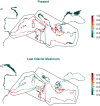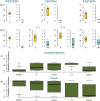Palaeoclimatic conditions in the Mediterranean explain genetic diversity of Posidonia oceanica seagrass meadows
- PMID: 28577023
- PMCID: PMC5457430
- DOI: 10.1038/s41598-017-03006-2
Palaeoclimatic conditions in the Mediterranean explain genetic diversity of Posidonia oceanica seagrass meadows
Erratum in
-
Author Correction: Palaeoclimatic conditions in the Mediterranean explain genetic diversity of Posidonia oceanica seagrass meadows.Sci Rep. 2020 Apr 3;10(1):6053. doi: 10.1038/s41598-020-62684-7. Sci Rep. 2020. PMID: 32246040 Free PMC article.
Abstract
Past environmental conditions in the Mediterranean Sea have been proposed as main drivers of the current patterns of distribution of genetic structure of the seagrass Posidonia oceanica, the foundation species of one of the most important ecosystems in the Mediterranean Sea. Yet, the location of cold climate refugia (persistence regions) for this species during the Last Glacial Maximum (LGM) is not clear, precluding the understanding of its biogeographical history. We used Ecological Niche Modelling together with existing phylogeographic data to locate Pleistocene refugia in the Mediterranean Sea and to develop a hypothetical past biogeographical distribution able to explain the genetic diversity presently found in P. oceanica meadows. To do that, we used an ensemble approach of six predictive algorithms and two Ocean General Circulation Models. The minimum SST in winter and the maximum SST in summer allowed us to hindcast the species range during the LGM. We found separate glacial refugia in each Mediterranean basin and in the Central region. Altogether, the results suggest that the Central region of the Mediterranean Sea was the most relevant cold climate refugium, supporting the hypothesis that long-term persistence there allowed the region to develop and retain its presently high proportion of the global genetic diversity of P. oceanica.
Conflict of interest statement
The authors declare that they have no competing interests.
Figures





Similar articles
-
Dramatic loss of seagrass habitat under projected climate change in the Mediterranean Sea.Glob Chang Biol. 2018 Oct;24(10):4919-4928. doi: 10.1111/gcb.14401. Epub 2018 Aug 3. Glob Chang Biol. 2018. PMID: 30006980
-
Contribution of Posidonia oceanica meadows in the context of climate change mitigation in the Mediterranean Sea.Mar Environ Res. 2021 Mar;165:105236. doi: 10.1016/j.marenvres.2020.105236. Epub 2020 Dec 15. Mar Environ Res. 2021. PMID: 33360312
-
Decline of seagrass (Posidonia oceanica) production over two decades in the face of warming of the Eastern Mediterranean Sea.New Phytol. 2023 Sep;239(6):2126-2137. doi: 10.1111/nph.19084. Epub 2023 Jun 27. New Phytol. 2023. PMID: 37366062
-
Sustainable Exploitation of Posidonia oceanica Sea Balls (Egagropili): A Review.Int J Mol Sci. 2023 Apr 14;24(8):7301. doi: 10.3390/ijms24087301. Int J Mol Sci. 2023. PMID: 37108463 Free PMC article. Review.
-
An Overview of New Insights into the Benefits of the Seagrass Posidonia oceanica for Human Health.Mar Drugs. 2021 Aug 25;19(9):476. doi: 10.3390/md19090476. Mar Drugs. 2021. PMID: 34564138 Free PMC article. Review.
Cited by
-
Resilience of seagrass populations to thermal stress does not reflect regional differences in ocean climate.New Phytol. 2022 Feb;233(4):1657-1666. doi: 10.1111/nph.17885. Epub 2021 Dec 14. New Phytol. 2022. PMID: 34843111 Free PMC article.
-
Shared genomic outliers across two divergent population clusters of a highly threatened seagrass.PeerJ. 2019 Apr 29;7:e6806. doi: 10.7717/peerj.6806. eCollection 2019. PeerJ. 2019. PMID: 31106053 Free PMC article.
-
Integrating within-species variation in thermal physiology into climate change ecology.Philos Trans R Soc Lond B Biol Sci. 2019 Aug 5;374(1778):20180550. doi: 10.1098/rstb.2018.0550. Epub 2019 Jun 17. Philos Trans R Soc Lond B Biol Sci. 2019. PMID: 31203756 Free PMC article.
-
The fate of endemic insects of the Andean region under the effect of global warming.PLoS One. 2017 Oct 16;12(10):e0186655. doi: 10.1371/journal.pone.0186655. eCollection 2017. PLoS One. 2017. PMID: 29036214 Free PMC article.
-
Historic and contemporary biogeographic perspectives on range-wide spatial genetic structure in a widespread seagrass.Ecol Evol. 2023 Mar 19;13(3):e9900. doi: 10.1002/ece3.9900. eCollection 2023 Mar. Ecol Evol. 2023. PMID: 36950371 Free PMC article.
References
-
- Templado, J. In The Mediterranean Sea: Its History and Present Challenges 479–498 (Springer Netherlands, 2014), doi:10.1007/978-94-007-6704-1_28.
-
- Patarnello T, Volckaert FAMJ, Castilho R. Molecular Ecology. 2007. Pillars of Hercules: Is the Atlantic-Mediterranean transition a phylogeographical break? pp. 4426–4444. - PubMed
-
- Danovaro R, Dinet A, Duineveld G, Tselepides A. Benthic response to particulate fluxes in different trophic environments: a comparison between the Gulf of Lions–Catalan Sea (western-Mediterranean) and the Cretan Sea (eastern-Mediterranean) Prog. Oceanogr. 1999;44:287–312. doi: 10.1016/S0079-6611(99)00030-0. - DOI
-
- Alberto F, et al. Genetic differentiation and secondary contact zone in the seagrass Cymodocea nodosa across the Mediterranean-Atlantic transition region. J. Biogeogr. 2008;35:1279–1294. doi: 10.1111/j.1365-2699.2007.01876.x. - DOI
Publication types
MeSH terms
LinkOut - more resources
Full Text Sources
Other Literature Sources
Miscellaneous

